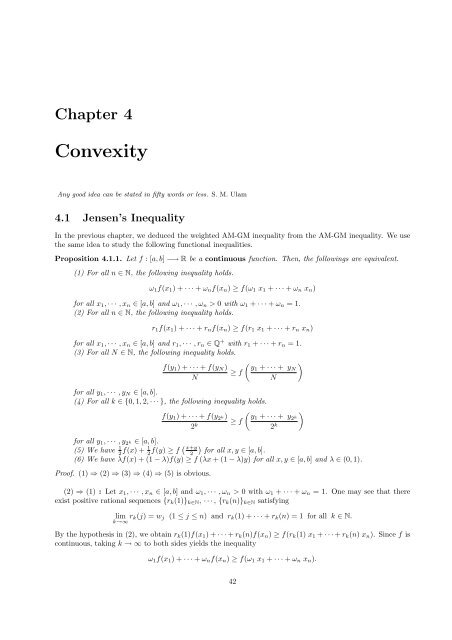Topics in Inequalities - Theorems and Techniques Hojoo ... - Index of
Topics in Inequalities - Theorems and Techniques Hojoo ... - Index of
Topics in Inequalities - Theorems and Techniques Hojoo ... - Index of
You also want an ePaper? Increase the reach of your titles
YUMPU automatically turns print PDFs into web optimized ePapers that Google loves.
Chapter 4<br />
Convexity<br />
Any good idea can be stated <strong>in</strong> fifty words or less. S. M. Ulam<br />
4.1 Jensen’s Inequality<br />
In the previous chapter, we deduced the weighted AM-GM <strong>in</strong>equality from the AM-GM <strong>in</strong>equality. We use<br />
the same idea to study the follow<strong>in</strong>g functional <strong>in</strong>equalities.<br />
Proposition 4.1.1. Let f : [a, b] −→ R be a cont<strong>in</strong>uous function. Then, the follow<strong>in</strong>gs are equivalent.<br />
(1) For all n ∈ N, the follow<strong>in</strong>g <strong>in</strong>equality holds.<br />
ω 1 f(x 1 ) + · · · + ω n f(x n ) ≥ f(ω 1 x 1 + · · · + ω n x n )<br />
for all x 1 , · · · , x n ∈ [a, b] <strong>and</strong> ω 1 , · · · , ω n > 0 with ω 1 + · · · + ω n = 1.<br />
(2) For all n ∈ N, the follow<strong>in</strong>g <strong>in</strong>equality holds.<br />
r 1 f(x 1 ) + · · · + r n f(x n ) ≥ f(r 1 x 1 + · · · + r n x n )<br />
for all x 1 , · · · , x n ∈ [a, b] <strong>and</strong> r 1 , · · · , r n ∈ Q + with r 1 + · · · + r n = 1.<br />
(3) For all N ∈ N, the follow<strong>in</strong>g <strong>in</strong>equality holds.<br />
( )<br />
f(y 1 ) + · · · + f(y N ) y1 + · · · + y N<br />
≥ f<br />
N<br />
N<br />
for all y 1 , · · · , y N ∈ [a, b].<br />
(4) For all k ∈ {0, 1, 2, · · · }, the follow<strong>in</strong>g <strong>in</strong>equality holds.<br />
f(y 1 ) + · · · + f(y 2 k)<br />
2 k ≥ f<br />
( )<br />
y1 + · · · + y 2 k<br />
2 k<br />
for all y 1 , · · · , y 2 k ∈ [a, b].<br />
(5) We have 1 2 f(x) + 1 2 f(y) ≥ f ( )<br />
x+y<br />
2 for all x, y ∈ [a, b].<br />
(6) We have λf(x) + (1 − λ)f(y) ≥ f (λx + (1 − λ)y) for all x, y ∈ [a, b] <strong>and</strong> λ ∈ (0, 1).<br />
Pro<strong>of</strong>. (1) ⇒ (2) ⇒ (3) ⇒ (4) ⇒ (5) is obvious.<br />
(2) ⇒ (1) : Let x 1 , · · · , x n ∈ [a, b] <strong>and</strong> ω 1 , · · · , ω n > 0 with ω 1 + · · · + ω n = 1. One may see that there<br />
exist positive rational sequences {r k (1)} k∈N , · · · , {r k (n)} k∈N satisfy<strong>in</strong>g<br />
lim r k(j) = w j (1 ≤ j ≤ n) <strong>and</strong> r k (1) + · · · + r k (n) = 1 for all k ∈ N.<br />
k→∞<br />
By the hypothesis <strong>in</strong> (2), we obta<strong>in</strong> r k (1)f(x 1 ) + · · · + r k (n)f(x n ) ≥ f(r k (1) x 1 + · · · + r k (n) x n ). S<strong>in</strong>ce f is<br />
cont<strong>in</strong>uous, tak<strong>in</strong>g k → ∞ to both sides yields the <strong>in</strong>equality<br />
ω 1 f(x 1 ) + · · · + ω n f(x n ) ≥ f(ω 1 x 1 + · · · + ω n x n ).<br />
42

















